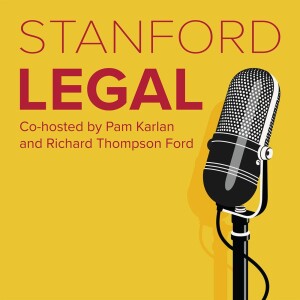
High Court, High Stakes: The Massive Weight of Recent Supreme Court Rulings
 2024-08-29
2024-08-29
The Supreme Court's latest term was marked by decisions of enormous consequence. However, the way the Court has communicated about these rulings far undersells the gravity they carry.
While “expressing itself in extremely modest terms,” Professor Jeffrey Fisher says, the current Supreme Court has “[handed] down decisions that have enormously consequential effects for our democracy, people's rights, and everything in between.” He and Assistant Professor Easha Anand, co-directors of the Supreme Court Litigation Clinic, agree that these recent decisions could reshape American law and politics for years to come.
In this episode of Stanford Legal with host Pam Karlan, Fisher, and Anand take a critical look at recent Supreme Court rulings on abortion, gun rights, tech platforms, and the power of federal agencies, examining the Court's evolving approach and considering the potential long-term impacts on American democracy and the rule of law.
Connect:
- Episode Transcripts >>> Stanford Legal Podcast Website
- Stanford Legal Podcast >>> LinkedIn Page
- Rich Ford >>> Twitter/X
- Pam Karlan >>> Stanford Law School Page
- Stanford Law School >>> Twitter/X
- Stanford Law Magazine >>> Twitter/X
Links:
- Jeff Fisher >>> Stanford Law School Page
- Easha Anand >>> Stanford Law School Page
- Stanford Supreme Court Litigation Clinic >>> Stanford Law School Page
(00:00:00) Chapter 1: Introduction to the Supreme Court Term and Key Cases
Pam Karlan is joined by Professors Jeff Fisher and Easha Anand to discuss the past term at the Supreme Court, constitutional law and Supreme Court practice, highlighting key cases and themes from the term. They explore how the court's conservative majority shapes the docket and the role of Justices Barrett and Jackson in developing their judicial voices.
(00:06:56) Chapter 2: High-Profile Cases: Guns, Abortion, and Administrative Law
Examine major cases, including gun rights in Rahimi v. United States and Cargill v. Garland, abortion-related cases, and the pivotal Loper Bright decision affecting the administrative state. They analyze the court's reasoning and the broader implications of these rulings.
(00:15:28) Chapter 3: The Court's Evolving Role and Methodology
Discussion of the broader implications of the Supreme Court's evolving approach to its docket and decision-making processes, particularly in relation to the administrative state and the impact of recent rulings on future cases.
(00:19:14) Chapter 4: The Supreme Court and Technology Cases
They delve into the significant technology cases that were brought before the Supreme Court this term. They discuss how the Court addressed state laws from Florida and Texas aimed at restricting content moderation by big tech companies, marking the first time the First Amendment was applied to social media platforms. The discussion highlights the tension between traditional legal frameworks and the evolving digital landscape, with a focus on the implications of these rulings for the future of free speech online.
(00:24:10) Chapter 5: Trump and the Supreme Court: Balancing Power and Immunity
The group explores the complex legal landscape surrounding former President Donald Trump's involvement in Supreme Court cases. Easha Anand provides an in-depth analysis of the Trump v. United States case, where the Court examined the extent of presidential immunity concerning acts related to the 2020 election. The discussion also touches on the broader implications of the Court's rulings on Trump’s legal challenges, including how these decisions might shape future presidential conduct and accountability.
(00:29:27) Chapter 6: Supreme Court’s Role in Protecting Democracy
Pam Karlan and Jeff Fisher discuss the Supreme Court's role in safeguarding democratic processes. They analyze the Court's reluctance to engage deeply in political matters, such as the January 6th prosecution and political gerrymandering, highlighting the tension between judicial restraint and the need to protect democratic values. The chapter concludes with reflections on the broader implications of these decisions for the future of U.S. democracy, particularly in the context of voting rights and election integrity.
More Episodes
 2024-04-11
2024-04-11
 2024-02-15
2024-02-15
Create your
podcast in
minutes
- Full-featured podcast site
- Unlimited storage and bandwidth
- Comprehensive podcast stats
- Distribute to Apple Podcasts, Spotify, and more
- Make money with your podcast
It is Free
- Privacy Policy
- Cookie Policy
- Terms of Use
- Consent Preferences
- Copyright © 2015-2024 Podbean.com





